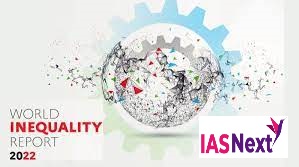CURRENT AFFAIRS
Get the most updated and recent current affair content on Padhaikaro.com
World Inequality Report
- IAS NEXT, Lucknow
- 10, Dec 2021

Reference News:
The 2022 World Inequality Report (WIR) has been released.
What you need to know about the WIR?
- Released by the World Inequality Lab, a research center at the Paris School of Economics.
- The WIR studies different kinds of financial data to find out how a country’s (and the world’s) income and wealth are distributed.
Significance of the report– why do we need a study on inequalities?
This is vital information because in most democracies, the wealthy can, and do, transform their economic power into political power, and therefore, the higher the inequality, the greater the likelihood that an affluent minority could end up determining the fate of the majority. Availability of accurate data about levels of inequality can help generate public opinion in favour of policy measures that can mitigate them.
Key findings of the 2022 report:
- The gap between the rich and the poor in terms of share of national income is quite large, and growing rapidly as a result of government policies that favour the affluent elite. The richest 10% of the global population takes home 52% of the global income, whereas the poorest 50% got only 8.5% of it.
- Global wealth inequities are worse than income inequalities. While the poorest 50% own just 2% of the global wealth, the richest 10% own 76% of all the wealth.
- Inequality between countries was narrowing while inequality within countries was increasing. While the gap between the average incomes of the richest 10% of countries and the average incomes of the poorest 50% of countries has dropped from 50x to less than 40x, the gap between the average incomes of the top 10% and the bottom 50% of individuals within countries has almost doubled, from 8.5x to 15x.
- Countries are growing richer, governments are becoming poorer: The share of privately owned wealth in national wealth was rising, while that of public wealth (buildings, universities, roads, hospitals etc) was shrinking.
Inequality across the continents:
While Europe was the region with the least amount of inequality (the income share of the top 10% was 36%), inequality was highest in the MENA (Middle East and North Africa (MENA) region, where the share of the top 10% was 58%.
Income inequality in India:
- India is one of the world’s most unequal countries, with the top 1% getting 21.7% of the national income.
- Top 10% of Indians capture 57% of the national income, while the share of the bottom 50% is only 13%.
- While the average national income of the bottom 50% stood at ₹53,610, the top 10% earned more than 20 times more, ₹11,66,520.
Inequality in India- Before and after 1947:
Income inequality in India today is worse than it was under British rule. Under the British (1858-1947), the top 10% got about 50% of the national income (lower than today’s 57%).
- In the decades after India got independence, socialistic economic policies reduced income inequality, bringing the share of the top 10% to 35-40%.
- But starting from the 1980s, the report states, “deregulation and liberalisation policies have led to one of the most extreme increases in income and wealth inequality observed in the world.”
Overall learning from the report:
The report points out that inequality and poverty are not inevitable but mainly the effect of policy choices.
It tracks how inequalities burgeoned around the globe from the 1980s onward – in contrast to the previous three decades – following the liberalisation programmes that were implemented in different countries. It recommends wealth taxes on the super-rich and a robust redistribution regime as policy measures that could arrest, if not reverse, the current trend of rising inequality.